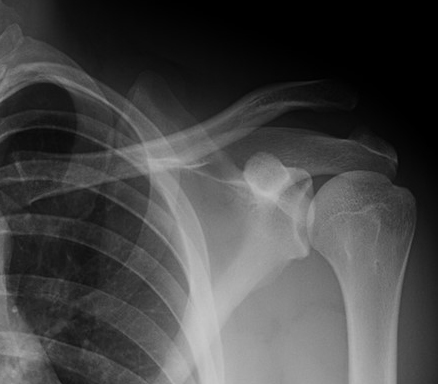How would you treat a young athlete with a chronic AC injury?
Click Here to Manage Email Alerts
The patient is a young active athlete with a chronic grade III acromioclavicular separation. He presents 5 months after injury with unknown previous treatment. The general consensus regarding the treatment of acute grade III injuries is to employ nonoperative treatment for 8 weeks to 12 weeks followed by examination to evaluate residual pain and/or dysfunction. However, in the chronic setting, the role of nonoperative management is unclear. The primary indicator for operative treatment is pain. Secondary factors that may indicate operative treatment include weakness and loss of motion in the extremity.
Weaver-Dunn procedure variations
Variations of the Weaver-Dunn procedure have been one of the common methods for reconstructing the acromioclavicular (AC) joint. The procedure involves the resection of the distal clavicle, and rerouting the coracoacromial ligament to the distal clavicle. Modern variations include suture augmentation around the clavicle and coracoid to improve the strength of this construct. Several reports have described good results with modifications of the Weaver-Dunn technique. However, residual subluxation has been described with this technique.

A 22-year-old patient presents with shoulder separation due to an injury during a lacrosse game 5 months ago. The patient has persistent pain and persistent weakness. What would you do – an arthroscopic AC reconstruction, open anatomic reconstruction, Weaver Dunn or tell him to “shake hands with it"?
Credit: Mazzocca AD
Our preferred approach is the anatomic coracoclavicular reconstruction (ACCR). The experience of the senior author in addition to the results of multiple clinical and biomechanical studies have led to the development of several anatomic principles that guide operative treatment of the dislocated AC joint: (1) respect the bony anatomy of the clavicle and acromion meaning no significant resection of the distal clavicle in order to prevent further instability to the joint, (2) reconstruction of both the conoid and trapezoid ligaments in order to anatomically reproduce the native coracoclavicular (CC) ligaments to most effectively reproduce the native stability of the joint, and (3) the reconstruction needs to effectively reproduce the native 3-D motion pattern of the joint while simultaneously providing stability. Prospective clinical and biomechanical studies of the ACCR technique have shown superior strength, decreased anterior-posterior translation, better subjective and radiographic outcomes when compared to the modified Weaver-Dunn. Disadvantages include the potential risk for clavicle fracture.
Preferred method
Our preferred method is a mini-open approach to better visualize and reduce the CC interval and AC joint. The disadvantage of the technique is increased soft tissue dissection and the inability to visualize the inferior coracoid when passing suture or graft. The arthroscopic ACCR has also been popularized by the European surgeons in acute cases where the CC interval and AC joint can be close reduced. The advantage of this technique is the ability to visualize the inferior coracoid and minimize the soft tissue dissection. However, the reduction of the CC interval and AC joint is difficult, if not impossible, to achieve by closed means in the chronic setting.
The European technique involves the anatomical reconstruction of the CC ligaments with a special fiber suture construction secured with small drill tunnels and two precontoured buttons on the clavicle and coracoid respectively. This is accompanied with an autologous hamstring graft in the chronic setting. If there is clinical and radiological evidence of horizontal (AP) instability, the AC ligaments will also be addressed by adding a resorbable suture cerclage around the AC joint.
References:
Beitzel K. Arthroscopy. 2013; doi:10.1016/j.arthro.2012.11.023.
Beitzel K. Knee Surg Sports Traumatol Arthrosc. 2012;20(10):1931-1938.
Braun S. Oper Orthop Traumatol. 2014; doi:10.1007/s00064-013-0276-x.
Larsen E. J Bone Joint Surg (Am). 1986;68(4): 552-555.
Mazzocca AD. Am J Sports Med. 2006;34(2):236-246.
McFarland EG. Am J Orthop. 1997;26(11):771-774.
Spencer EE Jr. Clin Orthop Relat Res. 2007;455:38-344.
Tienen TG. Am J Sports Med. 2003;31(5): 655-659.
Rios CG. Clin Sports Med. 2008; doi:10.1016/j.csm.2008.06.006.
Trainer G. Clin J Sport Med. 2008; doi:10.1097/JSM.0b013e318169f4c1.
Tauber M. Am J Sports Med. 2009; doi:10.1177/0363546508323255.
Michlitsch MG. Am J Sports Med. 2010; doi:10.1177/0363546509361160.
Saier T. Value of additional acromioclavicular cerclage for horizontal stability in complete acromioclavicular separation: a biomechanical study. Knee Surg Sports Traumatol Arthrosc. 2014 Feb 21; ePub ahead of print.
Weaver JK. J Bone Joint Surg (Am). 1972; 54(6): 187-1194.
Weinstein DM. Am J Sports Med. 1995; 23(3):324-331.
Augustus D. Mazzocca, MD, is the director of UConn Musculoskeletal Institute, and professor and chairman of the Department of Orthopaedic Surgery at the University of Connecticut. Justin S. Yang, MD, is an orthopedic sports medicine fellow, Andreas Voss, MD, is an orthopedic research fellow, and John Apostolakos, BS is an orthopedic research assistant all in the Department of Orthopaedic Surgery at the University of Connecticut.
Disclosures: Apostolakos, Voss and Yang have no relevant financial disclosures. Mazzocca is a consultant for and receives research support from Arthrex.
